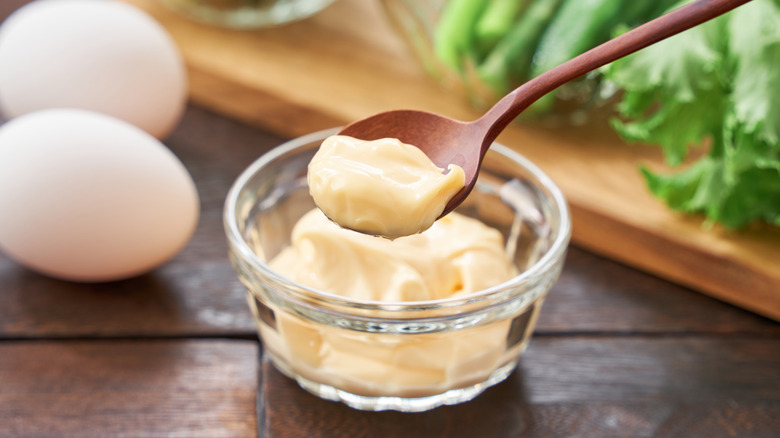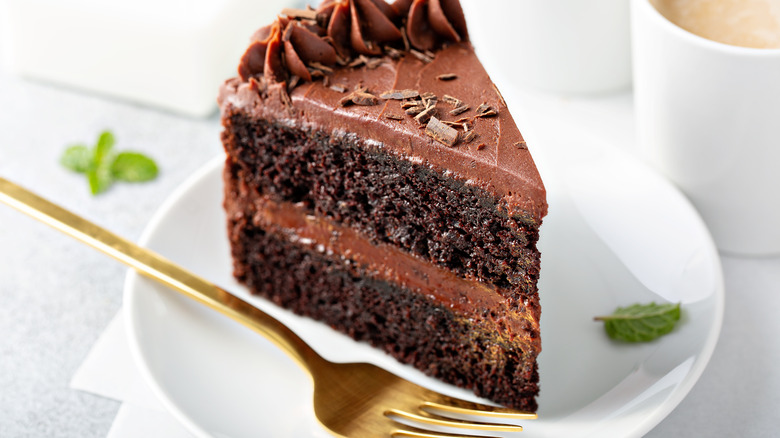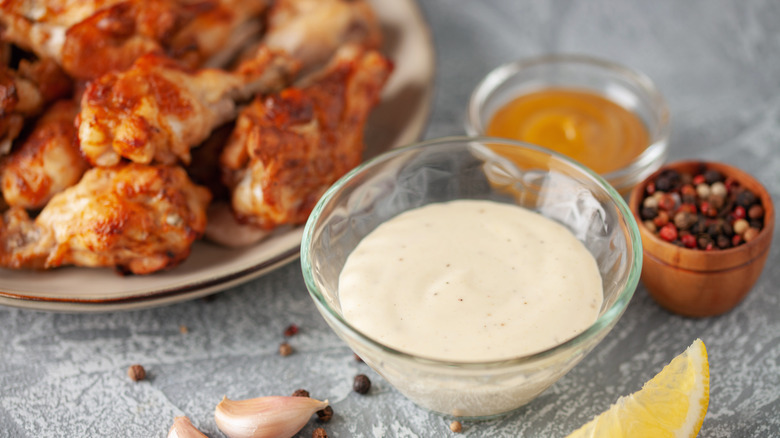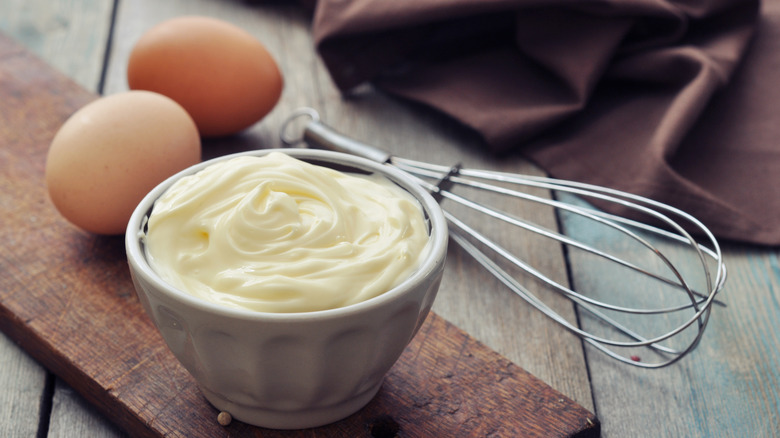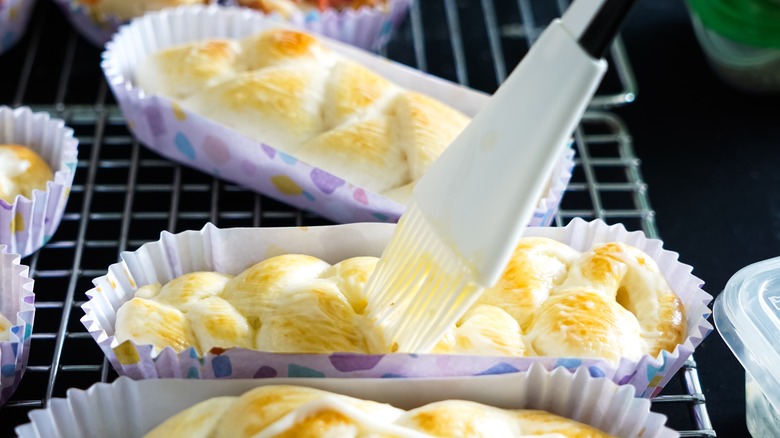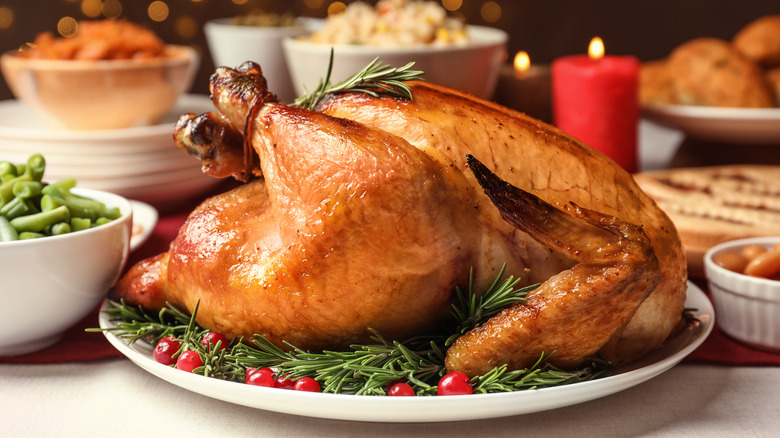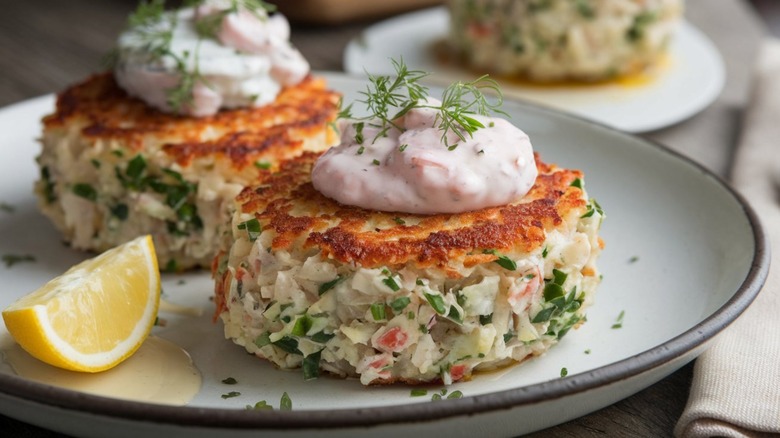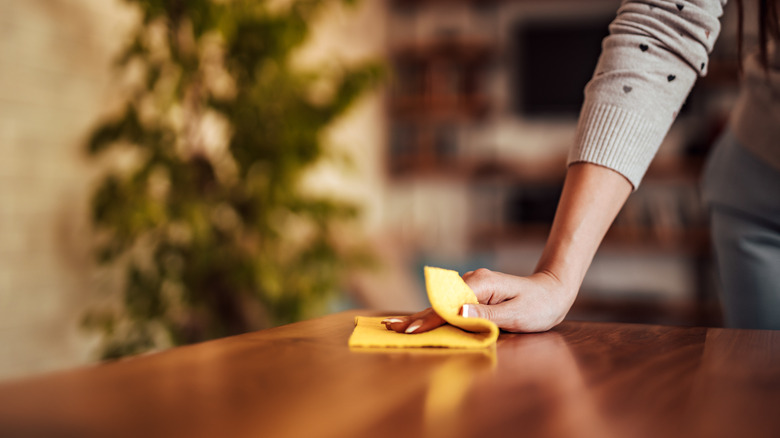13 Ways To Use Mayonnaise That You Need To Try ASAP
People can be passionate about their mayonnaise. Those who really consider themselves to be staunch fans will often have a favorite mayo brand, like Hellmann's or Duke's, and swear that no other can even begin to compare. However, even if you really love this condiment, the ways in which you typically use it might be growing a little stale. Sure, you reach for mayo over ketchup anytime you need a dipping sauce for your fries. You know that the best BLT, the most indulgent burger, and other handheld meals require a very large serving of mayonnaise. You dollop it into your pasta salads, and maybe you've even been known to eat a spoonful straight from the jar when no one is looking. But could you also be using your mayonnaise in more creative ways?
No mere condiment, mayonnaise is simple at its root. It's made up of eggs, oil, and an acid. But while this combination is straightforward, it also allows for incredible versatility. Mayonnaise's wide range of potential uses is unique, maybe even magical. Here are some of the best ways to use mayonnaise that you need to try ASAP, if you haven't yet.
In your scrambled eggs
When it comes to what the perfect scrambled egg should look and taste like, opinions differ. Some like their eggs a little runny. Some like them fluffy. But one thing that nobody wants is a dry scrambled egg. A great way to get creamy, silky-smooth scrambled eggs is to cook them on low heat, and very slowly. While this technique produces rave-worthy reviews, though, it requires time, and patience that many of us don't have.
As an alternative, there are myriad ingredients you can use to quickly boost your scrambled eggs' moisture content, including olive oil, butter, and milk. An underutilized addition to scrambled eggs, and one sure to improve the texture, is mayonnaise. If you do add mayo to your next batch of scrambled eggs, aim for a ratio of about half a tablespoon of mayo per egg. You won't need to add any other liquid, such as the typical water or milk, to the eggs as you whisk them. After you've incorporated the mayo, cook the eggs like you normally would.
As a swap for butter on your grilled cheese
A grilled cheese should be perfectly golden brown, and crispy on the outside; melty and gooey on the inside. To achieve these optimal results, many use butter. However, if you've ever got a hankering for a grilled cheese sandwich, you may know that scraping cold butter onto a piece of white bread will tear that poor slice of bread to shreds. This is a surefire way to grow frustrated, and give up before you even get the chance to glimpse that crispy-melty-gooey perfection.
Luckily, mayo is here to the rescue. Skip the cold butter battle entirely, and simply coat each slice of bread in a thin layer of mayonnaise. It's the secret to making the crispiest grilled cheese you've ever had, and mayonnaise is superior to butter on a grilled cheese for reasons beyond just easy spreading. For one, mayonnaise has a higher smoke point than butter: 450 degrees Fahrenheit to butter's 300–350 degrees. This means you can allow the sandwich to cook until it's just right on the outside, and also the inside. It's a better way to achieve the results of the Maillard reaction, which causes food to brown, and develop rich flavor, without worrying about burning. At the same time, the mayonnaise will keep your bread's interior moist, so it doesn't dry out.
To achieve a super-moist cake
While mayonnaise may be thought of as a savory ingredient, it actually has a few sweet applications as well. For example, it's an excellent addition to your favorite from-scratch chocolate cake recipe. Think about it: Mayonnaise is basically just oil, and eggs. If you were making a boxed cake, the directions would probably tell you to add these two ingredients to the cake mix, anyway.
However, the reason why mayonnaise works well in cake goes deeper than that. When you add mayonnaise directly to your cake's dry ingredients, in lieu of any extra oil or eggs, you're mimicking the reverse creaming baking technique, which involves adding fat to dry ingredients before adding any other liquid. This allows the fat to coat the flour more effectively, preventing excess gluten from forming, which in turn makes for a tenderer crumb, with less risk of toughness.
Fans of the reverse creaming technique say that it results in the moistness of a boxed cake mix, and the flavor of a homemade cake recipe. Using mayonnaise in your cake in place of eggs and oil gives you the same result as the reverse creaming technique, but easier, and faster.
For marinating meats
The factors that make mayonnaise a great swap for butter on your grilled cheese are the same that make mayonnaise awesome for marinating meats, and vegetables before grilling or roasting. The high smoke point protects the food from burning before its time, and ensures that you don't end up with a smoky mess on your grill, or in your high-heat oven. The oil and eggs succumb to the Maillard reaction, resulting in perfect browning, and all the flavors that come with it. Plus, the fatty mayo adds a certain richness to foods that you might not get with a regular oil-based marinade, while also sealing in moisture that might otherwise be lost when grilling foods like chicken.
Plus, making a marinade with mayo couldn't be simpler. You really just need mayonnaise, plus the seasonings of your choice. However, if you do want to get a little more creative, that's an option, too. Mayonnaise makes a suitable blank canvas on which to paint a broader collection of flavors.
As a leavening ingredient
A leavening agent is any ingredient in a baked item that helps that baked item to rise, and become lighter during the cooking process. There are many different leavening agents, including yeast, baking soda, and baking powder. Some are better suited to certain tasks than others. Eggs can be used as a leavening ingredient, as they add moisture to a recipe, creating steam that helps the baked item rise. Additionally, whipped egg whites expand, and create air cells that further lighten, and lift a baked good. The egg proteins, meanwhile, work alongside gluten to give these air cells structure, and stability. If you add in an acidic ingredient, the egg whites become even more stable.
Whipping egg whites to be used in a baking project can be time-consuming, and a challenge with myriad pitfalls for novice bakers. Mayonnaise, with its existing eggs and acid, is sitting right there. So, when you want to avoid whipping egg whites, or you just don't have any eggs on hand for a baking project, choose mayonnaise as your leavening ingredient instead.
In place of an egg wash
An egg wash, applied to a baked item right before it's popped into the oven, can give your pie crust or pastries a shiny, golden appearance. It can enhance a crust's texture, providing crispiness, and also act like a glue, keeping toppings adhered to pastries, and intricate pastry work intact. However, unless you're working on a rather large baking project, you may find that making an egg wash for just one pie feels a little wasteful. Instead of being left wondering what to do with all that leftover egg, consider mayonnaise. The handy condiment can take the place of an egg if you're in need of an egg wash.
In cases like these, mayonnaise can be used in place of an egg wash to help your baked items achieve a nice golden hue, thanks to the mayo's egg, and oil content. While using straight mayo as an egg wash won't affect the taste of your baked item to a large degree, if you think the acidic tang might not jive well with your pastry, keep your mayo egg wash for savory baked goods, like breads.
For frying chicken
An egg wash isn't only used to give baked goods their beautiful, professional-looking sheen. It's also a requisite for frying. An egg wash acts as the binding agent that keeps whatever you're using as a crust, such as a crumb mixture or flour, adhered to the item you're frying. But, again, it isn't always an ideal option.
One potential problem stems from the fact that you have to dip your food into a bowl of raw eggs before dredging it in flour or crumbs, sometimes repeating this process multiple times. Over time, your fingers end up getting as breaded as the food, and raw egg goes everywhere, despite your best efforts to stay clean. Mayonnaise, though, makes a good stand-in, offering less mess, and fewer worries about spreading salmonella around your kitchen. The mayonnaise can act as a very effective binder, so you don't lose any of your breading during the cooking process. At the same time, it can add flavor, and moisture. The fat helps the breading crisp up, and brown evenly. This is true regardless of whether you're frying traditionally, or "frying" in the oven or air fryer.
As a salad dressing
We all see mayonnaise as a main component of non-green salads, like tuna salad, pasta salad, and potato salad. However, when it comes to tossing leafy greens at home, mayo is less mainstream. It's time we changed that.
Mayonnaise makes the perfect, creamy base for a quick, easy salad dressing that's completely customizable to whatever ingredients you have on hand. You can combine mayo with mustard, vinegar, and seasonings to whip up a tangy dressing that's ultra easy. If you really like mayonnaise, and don't mind that being the dominant flavor on your bed of lettuce, go super straightforward with just a mixture of mayo, milk, salt, and pepper. If you're not totally keen on a mayo-forward flavor profile, you can instead take advantage of the condiment's creaminess, and incorporate similarly creamy ingredients, such as sour cream and yogurt, in equal portions. This will result in a cool, smooth, slightly acidic dressing that's especially great with lots of fresh, chopped herbs mixed into it.
To roast vegetables
Mayonnaise offers an excellent way to better achieve the crispy, browning effect of the Maillard reaction, allowing one to worry less about an oil's low smoke point ruining results, or nasty fumes clogging up the kitchen. For this reason, it's a great addition to many dishes, and is the unexpected ingredient you need for flavor-packed roasted vegetables.
If you've ever attempted to roast root veggies in olive oil at a high heat, you've likely opened your oven to find the oil burning before the veggies are quite done. What's more, if you use a lot of seasoning on those roasted vegetables, you may find that seasoning floating around in the oil, rather than sticking to the vegetables themselves. This doesn't happen when you use mayonnaise instead. Mayonnaise keeps your vegetables cooking evenly, browning without burning. It binds seasonings to your vegetables, while also adding its own acidic, tangy flavor to the party.
It's easy to make the swap. For about every pound of vegetables, you'll need about a tablespoon of mayonnaise. Toss the chopped veg in your mayo, and spread the mixture onto a sheet pan before roasting like you normally would.
In your mashed potatoes
If your family has a designated point person when it comes to potatoes for the holidays, they probably have their own so-called secrets to the perfect mashed potatoes. Some home cooks like to add a dollop of ranch dressing to mashed potatoes. Others mix in cream cheese, while some swear by sour cream. However, if you're not using mayonnaise in your mashed potatoes, you're missing out.
Of course, butter adds a fair amount of characteristic flavor to mashed potatoes, and you might not want to give that up. Rest assured, you don't need to replace all of your butter for mayo here, like you would if you were making a grilled cheese. But swapping out just a portion of the butter for mayo can result in a softer, smoother, creamier mash. Plus, compared to butter, mayonnaise will keep your mashed potatoes from hardening in the fridge. This makes it an especially smart trick to know if you're making them in advance, or just anticipating leftovers.
On your holiday turkey
For many home cooks, the holiday turkey is a big deal. If your family's entrusted you with the task of preparing the bird, it means they seriously believe in your cooking chops. A turkey is not a challenge to hand to a newbie. Working with a protein of that size can go sideways, fast, leaving you with a turkey that's dry, and flavorless. And while this might sound a little farfetched, yes, mayonnaise is the secret to an extra juicy holiday turkey.
Home cooks have all sorts of tactics for avoiding the dreaded dry turkey. You can brine it, but that's time intensive. You can stuff butter underneath the skin, but you also need that butter for your other holiday dishes. Mayonnaise, meanwhile, is right there, ready for the taking. All you have to do is mix your mayonnaise with the seasonings of your choice, and then coat that bird in it, inside and out. You can let the turkey sit like this, using the mayonnaise as a marinade, or you can roast it right away. With the mayo in place, you won't even need to baste. The mayo will give the bird a golden-brown exterior, while retaining moisture.
As a binding ingredient in crab cakes
When preparing crab cakes, it's crucial to include a binder. This is the ingredient that ensures your cakes actually stay in cake-like form, rather than falling to pieces during the cooking process. Many crab cake recipes will instruct you to use eggs as that binder. However, this is another situation where mayonnaise can, yet again, take the place of eggs, and do a superior job.
Mayonnaise is crucial for making the best crab cakes because its fat content improves the texture, allowing you to create a moister cake without sacrificing structure. Meanwhile, the acidic ingredient in any mayonnaise, like vinegar or lemon, will add extra flavor to the crab cake.
Just about any mayonnaise will work for this swap, including vegan mayonnaise. However, you'll want to steer clear of popular mayo substitutes, such as Greek yogurt, or sour cream. Since you already have mayonnaise acting as a substitute for the traditional eggs, you want to avoid using additional substitutions, as this can just get messy, and lead you too far astray from what the dish is actually supposed to be.
To clean your house
Once you've done all that cooking, your kitchen is probably going to need a bit of cleaning. Mayonnaise can help here, too. Mayonnaise works as an effective natural cleaner because the oil provides moisture, the vinegar provides actual cleaning power, and the egg helps the mayonnaise to stay where you stick it, so you can rub it onto a surface, and let it soak in for a while.
You can use mayonnaise to polish various metals, including stainless steel, brass, and silver. You can use it to remove unsightly water rings from a wooden table. You can even use it to remove crayon marks from walls. Typically, all you have to do is apply the mayonnaise to your surface of choice, wait a few minutes, and then buff it away, with little need for elbow grease.
Of course, as always, when trying any cleaning hack, it's important to test it before diving in head-first. Don't just slater a bunch of mayo across your wood floors, or on a piece of heirloom furniture. First, test your mayo cleaner in a spot that's not immediately noticeable. That way, if any discoloration does occur, it's not a huge deal.
